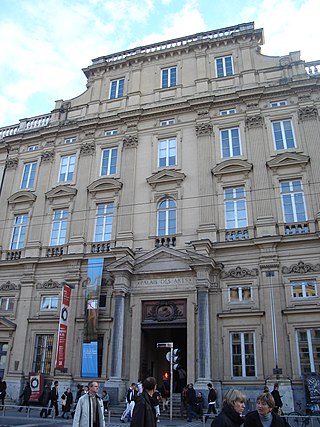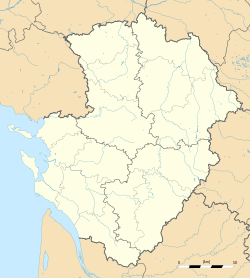
The Royal Abbey of Our Lady of Fontevraud or Fontevrault was a monastery in the village of Fontevraud-l'Abbaye, near Chinon, in the former French Duchy of Anjou. It was founded in 1101 by the itinerant preacher Robert of Arbrissel. The foundation flourished and became the centre of a new monastic Order, the Order of Fontevraud. This order was composed of double monasteries, in which the community consisted of both men and women — in separate quarters of the abbey — all of whom were subject to the authority of the Abbess of Fontevraud. The Abbey of Fontevraud itself consisted of four separate communities, all managed by the same abbess.

Venantius Honorius Clementianus Fortunatus, known as Saint Venantius Fortunatus, was a Latin poet and hymnographer in the Merovingian Court, and a bishop of the Early Church who has been venerated since the Middle Ages.

Radegund was a Thuringian princess and Frankish queen, who founded the Abbey of the Holy Cross at Poitiers. She is the patroness saint of several churches in France and England and of Jesus College, Cambridge.
Basina, was a Frankish princess, the daughter and youngest child of Chilperic I, King of Soissons, and his first wife, Audovera. After surviving the assassination of her immediate family, she became a nun. She later helped to lead a rebellion by a group of the nuns, which became a scandal throughout the region. This event was chronicled by the bishop and saint, Gregory of Tours, who was one of the bishops chosen to settle the matter.
Eufronius or Euphronius was the eighth Bishop of Tours; he served from 555 to 573, and was a near relative of Gregory of Tours.

Opportuna of Montreuil was a Frankish Benedictine nun and abbess. A Vita et miracula Sanctae Opportunae was written within a century of her death by Adalhelm, bishop of Séez, who believed he owed his life and his see to Opportuna.

The Collegiate Church of St. Gertrude is a Roman Catholic collegiate church in Nivelles, Walloon Brabant, Belgium, which was built in the 11th century. It is dedicated to Saint Gertude, the patron saint of cats.

The Church of Sainte-Radegonde is a medieval Roman Catholic church in Poitiers, France, dating from the 6th century. It takes its name from the Frankish queen and nun, Radegund, who was buried in the church. Considered a saint, the church became a place of pilgrimage by those devoted to her heavenly intercession. The current church, constructed from the 11th to 12th centuries, was built in a combination of Romanesque and Angevin Gothic architectural styles.
Saint Junian was a 6th-century Christian hermit and abbot. He was the founder of Mairé, or Mariacum, Abbey at Mairé-Levescault in Poitou, France and is the patron saint of Poitou ploughmen.
Baudonivia was a nun and hagiographer at the convent of Holy Cross of Poitiers. Very little is known about her. She wrote a biography of Radegund, Queen, founder of Holy Cross, and saint. Scholars have noticed a marked difference in perspective between an earlier life of Radegund composed by Venantius Fortunatus, written from a close friend's perspective, and Baudonivia's, written from the perspective of a nun of Radegund's own convent.

Anne d'Orléans was a French abbess. She was the youngest child of Charles, Duke of Orléans, and Maria of Cleves. Her only brother became King Louis XII of France in 1498.

Nivelles Abbey is a former Imperial Abbey of the Holy Roman Empire founded in 640. It is located in Nivelles, Walloon Brabant, Belgium.

The Abbey of Notre Dame aux Nonnains, also called the Royal Abbey of Our Lady of Troyes, was a convent founded before the 7th century in Troyes, France. The non-cloistered canonesses became wealthy and powerful in the Middle Ages. In 1266–68 they defied the pope and used force to delay construction of the collegiate Church of St Urbain. They were excommunicated as a result. Later the abbey adopted a strictly cloistered rule and the nuns became impoverished. Work started on building a new convent in 1778 but was only partially completed before the French Revolution (1789–99). The abbey was closed in 1792 and the church was demolished. The convent became the seat of the prefecture of Aube.
Edmond-René Labande (1908-1992) was a French archivist and historian.

St. Agnes of Poitiers is a French saint and abbess, who was "recognized for her holiness and intelligence" and called "model of the conventual life". She served as abbess of Holy Cross convent in Poitiers, France until her death in 586.

The Abbey of St Caesarius, at first called the abbey or monastery of St John, was a nunnery in the city of Arles in the south-eastern corner of the rampart. It was founded in 512 AD by Saint Caesarius of Arles, after whom it is now named. The abbey was suppressed in the French Revolution. Those that remained of the buildings were later used as a hospice; they are now adandoned.
Maroveus was the bishop of Poitiers in the late sixth century. He became bishop between 565 and 573, serving until sometime between 590 and 594.
Caesaria the Younger or Caesaria II was the abbess of Saint-Jean d'Arles from around 525 until her death.

The Abbey of Saint-Pierre-les-Nonnains in Lyon, also known as the Abbey of the Dames de Saint-Pierre or simply Palais Saint-Pierre, is an ancient Catholic religious edifice that housed Benedictine nuns from the 10th century onwards, and was rebuilt in the 17th century. Closed during the French Revolution, the former abbey is now home to the Musée des Beaux-Arts de Lyon.













